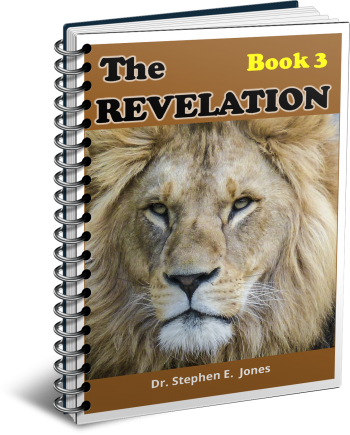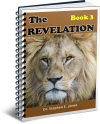Latest Posts
View the latest posts in an easy-to-read list format, with filtering options.

A study of Revelation 6-9. This is book 3 of an 8 part book series.
Category - Bible Commentaries

Revelation 6:7, 8 says,
7 And when He broke the fourth seal, I heard the voice of the fourth living creature saying, “Come.” 8 And I looked, and behold, an ashen [chloros, “green”] horse; and he who sat on it had the name Death; and Hades was following with him. And authority was given to them over a fourth of the earth, to kill with sword and with famine and with pestilence and by the wild beasts of the earth.
When the first four seals are broken, each living creature in its turn says to John, “Come.” Why does he not say, “Look and see!”? Why not “Hear this!” Why “come”? Where was John supposed to go?
It appears that the living creature was inviting John into a different dimension so that he might witness events on earth that were yet to come. In Rev. 4:1, John was invited to “Come up here,” where he witnessed the proceedings in the divine court in heaven. The seals were from the book in heaven, but the living creature wanted John to “come” back to earth to witness events that were to occur here.
This “ashen” (or green) horse was revealed by the fourth living creature, representing Joseph, or Ephraim, the Bull. Ephraim means “double fruitfulness,” and he received the birthright of his father, Joseph, who was “a fruitful bough” (Gen. 49:22). The blessing of Jacob was all about the abundance of fruitfulness “with blessings of heaven above, blessings of the deep that lies beneath, blessings of the breasts and of the womb” (Gen. 49:25). Moses adds his blessing “with the choice things of the earth and its fulness” (Deut. 33:16).
The blessings of the fourth living creature (the Calf, or Bull) around the throne are the blessings given to Joseph. Green is the color of life, resurrection, and abundance. But the fourth seal revealed the opposite being poured out upon the earth—that is, upon the Roman empire, the fourth beast.
Death is the inevitable result of the famine that was revealed by the third living creature. This was a time of famine, death, and decay of the Empire. At least one-fourth of the population of the Roman Empire perished during this time from famine or famine-related causes, such as disease. Gibbon estimates that close to half of the population of the Roman Empire died of starvation in just a 15-year period!
And so we date the Pale Horse era at the same time as the famine, particularly from 250-265 A.D. The fourth seal not only brought death to numerous individuals in the Empire, but it also brought death to the Empire itself. After Diocletian came to power in 284, he divided the Roman Empire into East and West a year later (285). Though the empire was reunified by Constantine thirty years later, even that reunification was temporary. Diocletian thus set the stage for the empire’s permanent division a century later. Gibbon says on page 124,
“Like Augustus, Diocletian may be considered as the founder of a new empire.
“After the example of Marcus, he gave himself a colleague in the person of Maximian, on whom he bestowed first the title of Caesar, and afterward that of Augustus.”
Seven years after splitting the Empire into two portions, the joint-emperors subdivided it again into four pieces. In 292 A.D., Diocletian and Maximian each appointed a lesser general with the title of Caesar to help them defend the empire from invasions. The other two Caesars were Galerius and Constantius.
Galerius, the Caesar of the East, later induced Diocletian to persecute and to destroy the Church. The result of this legislation brought about the terrible “tribulation” upon the church (Rev. 2:10) that lasted ten years (303-313 A.D.). However, most of this persecution was perpetrated in Italy and in the East by Maximian and Galerius. Constantius, who was responsible for the defense of the western Empire (Gaul, Spain, and Britain) favored the Christians and half-heartedly prosecuted just enough of them to do his duty as a Caesar.
The division of the empire into four parts meant that there were now four royal palaces and courts to maintain, instead of just one. Gibbon writes on pages 131, 132,
“The empire was divided into four parts. . . the political union of the Roman world was gradually dissolved, and a principle of division was introduced, which, in the course of a few years, occasioned the perpetual separation of the eastern and western empires.”
This division brought about a substantial increase in taxation as well in order to support the lavish courts of all four rulers. They competed with each other to portray greater pomp and luxury, and each had his own set of magistrates, ministers, and servants to fill their separate positions of government. The new taxes burdened the people further and added to the problem of famine that we saw earlier in the time of the third seal.
As I mentioned earlier, breaking the four seals revealed the signs of “the end of the age” that Jesus listed in Matthew 24.
The first seal, displaying a counterfeit conqueror on a white horse, was described in Matt. 24:4, 5,
4 And Jesus answered and said to them, “See to it that no one misleads you. 5 for many will come in My name, saying, ‘I am the Christ,’ and will mislead many.”
The Roman emperors, who wore the laurel wreaths (stephanos) and rode white horses, were deified as gods—false messiahs.
The second seal, portraying war on a red horse, was described next in Matt. 24:6, 7,
6 And you will be hearing of wars and rumors of wars; see that you are not frightened, for those things must take place, but that is not yet the end. 7 For nation will rise against nation, and kingdom against kingdom…
The Roman Empire began to experience revolts and wars from the death of Commodus in 193, resulting in the famines of the next phase of Roman history.
The third seal, portraying famine on a black horse, was described next in Matt. 24:7, 8,
7 … and in various places there will be famines and earthquakes. 8 But all these things are merely the beginning of birth pangs.
The famines from 250-265 A.D. killed about half the population of the Roman Empire, setting the stage for the death (dissolution) of the Empire itself.
The fourth seal, portrays death, not only by famine, sword, and pestilence, but also “by the wild beasts of the earth” (Rev. 6:8). While the first three forms of death came universally upon the Empire, the last was reserved primarily for the Christians in the arenas to provide amusement for the non-Christian crowds. So Jesus said in Matt. 24:9, 10, 13,
9 Then they will deliver you to tribulation, and will kill you, and you will be hated by all nations on account of My name. 10 And at that time many will fall away and will deliver up one another and hate one another…. 13 But the one who endures to the end, he shall be saved.
These four signs are patterns that are not necessarily limited to the decline and fall of Rome. Nonetheless, we see these patterns emerge at “the end of the age,” that is, the end of the fourth beast’s dominion. The iron beast of Rome, described in Dan. 7:7, was essentially broken up in 285 A.D., politically speaking, by Emperor Diocletian and further subdivided seven years later in 292.
This division of empire occurred just before its “Christian” phase under Constantine, beginning in 313, which partially fulfilled Jesus’ closing statement in regard to this sequence of signs. He said in Matt. 24:14,
14 And this gospel of the kingdom shall be preached in the whole world for a witness to all the nations, and then the end shall come.
When the persecution of Christians ceased with Constantine’s Edict of Toleration (313 A.D.), the church had almost unprecedented opportunity to spread the Gospel to all nations. The problem was that by this time the church was quite carnal, and this mindset caused many leaders to seek political power and to destroy anyone who did not subscribe to their established creeds. Hence, for many centuries the opportunity to convert the world by the love of Christ and by the demonstration of His Spirit was largely lost.
Unfortunately, the church adopted the ways of the nations, even as Israel had desired in the days of Samuel, when they asked the prophet, “appoint a king for us to judge us like all the nations” (1 Sam. 8:5). Their desire to be ruled by men, rather than by God, was an affront to God. Nevertheless, He granted their request, for we read in 1 Sam. 8:7,
7 And the Lord said to Samuel, “Listen to the voice of the people in regard to all that they say to you, for they have not rejected you, but they have rejected Me from being king over them.”
God then chose Saul as their king. Though Saul’s anointing was legitimate, it was not the perfect will of God, and so his reign was to be temporary. Saul was then crowned on the day of “wheat harvest” (1 Sam. 12:17), which was what the people called Pentecost, or the feast of weeks.
Hence, Saul was a type of the church in the Pentecostal Age. From the time of Constantine on, the characteristics of Saul became increasingly apparent in the church, complete with Saul’s persecution of David. Its persecution of “heretics” included persecuting the overcomers as well, for the church lacked the discernment to know the difference. It only knew its creeds, which replaced genuine faith as the standard of orthodoxy.
This persecution, along with the earlier ten-year persecution under Diocletian, gave pause to the breaking of the seals to commemorate the souls whose blood had been poured out under the altar of sacrifice. Their voice is then heard crying out to God in the next few verses before the revelation of the three final seals.